Introduction
Dalyan is a single page application project template using AngularJS, ASP.NET & Web API technologies. It is the base of a web application project. It has CRUD operation example with AngularJS. Additionally, WebAPI controllers and CRUD operations are created by T4 templates. You can download it from github source codes. This post describes step by step how to run this project and generate WebAPI CRUD Operations with T4 templates on Dalyan Project.
Content

What Are We Going to Build


Framework - Tools - Libraries
- Single Page Application
- AngularJS
- ASP.NET MVC 5
- ASP.NET Web API 2
- Entity Framework 6
- Mediator Design Pattern
- Owin Token Based Authentication
- Bootstrap 3
- Simple Injector Dependency Injection (DI)
- 3rd part libraries
- T4 Templates
- Microsoft Sql Server Express
Project Architecture

Configure Application
Open the Dalyan solution (Dalyan.sln) which is located in root directory and build the solution.
Publish Database Project
Database project has base tables and some data to test project.
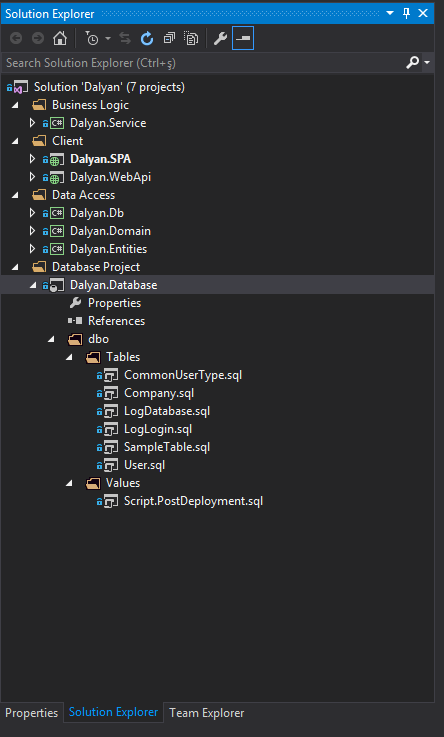
Open database project and click publish button.

Set your database connection string and create your database.

Set Connection Strings
Change Db project and Web API config files. This connection string is integrated so your IIS user need to permission to login your SQL server. You can change your connection string with username & password from following link.
http://www.connectionstrings.com/sql-server/
Dalyan.WebApi\Web.Config and Dalyan.Db\App.Config
<connectionStrings>
<add name="DbEntities"
connectionString="metadata=res://*/DbModel.csdl|res://*/DbModel.ssdl|
res://*/DbModel.msl;provider=System.Data.SqlClient;
provider connection string="data source=<code>.\SQLEXPRESS</code>;
initial catalog=Dalyan.Github;integrated security=True;
MultipleActiveResultSets=True;App=EntityFramework""
providerName="System.Data.EntityClient" />
</connectionStrings>
Ready to Run
It is ready to run. You can open the project in this link.
http://localhost/Dalyan.SPA/
Also web API link:
http://localhost/Dalyan.WebApi/
Default authentication:
admin@admin.com
Password: 1
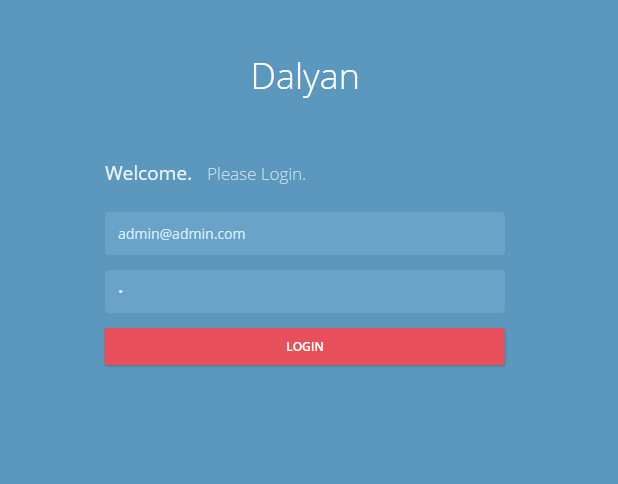
Generate Web API CRUD Operations Automatic With T4 Template on Dalyan Project
Step by step how to generate Web API CRUD Operations automatic With T4 Templates on Dalyan Project. First of all you have to create a sample table on your database. After T4 code generation you can call these web api methods;
- Add
- Edit
- Retrieve
- Delete
- GetAll
Lets do it
- Create a "product" table on SQL Server Database
- Add "product" table to Dalyan.Db Entity Framework Edmx model
- Add "product" table to defination xml file
- Generate DbModel with T4 template
- Generate ServiceQuery with T4 template
- Generate Service with T4 template
- Generate WebAPI controller with T4 template
- Check WebAPI actions
1. Create a "product" table on SQL Server Database
You have to add these columns to your new table. There is no delete operation on database. It is only update Isdeleted column to true. Also userid and date columns will bind Automatic.
[Id] [int] IDENTITY(1,1) NOT NULL, [CreatedDate] [datetime] NULL, [CreatedIpAddress] [nvarchar](50) NULL, [CreatedUserId] [int] NULL, [UpdatedDate] [datetime] NULL, [UpdatedIpAddress] [nvarchar](50) NULL, [UpdatedUserId] [int] NULL, [IsDeleted] [bit] NULL,
Create a test table for testing t4 templates which name is "Product"
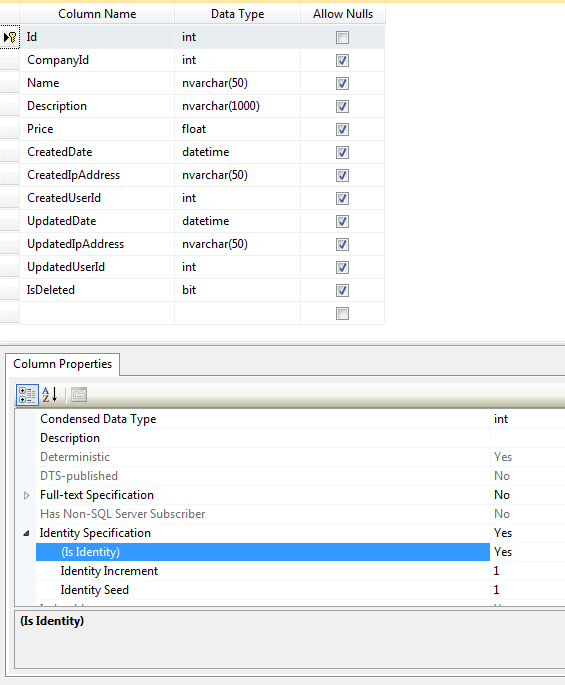
You can add relationship to your columns. I added CompanyId column relationship with Company table. On WebAPI response you can reach Company table with this relationship.

Table Create Script
SET ANSI_NULLS ON
GO
SET QUOTED_IDENTIFIER ON
GO
CREATE TABLE [dbo].[Product](
[Id] [int] IDENTITY(1,1) NOT NULL,
[CompanyId] [int] NULL,
[Name] [nvarchar](50) NULL,
[Description] [nvarchar](1000) NULL,
[Price] [float] NULL,
[CreatedDate] [datetime] NULL,
[CreatedIpAddress] [nvarchar](50) NULL,
[CreatedUserId] [int] NULL,
[UpdatedDate] [datetime] NULL,
[UpdatedIpAddress] [nvarchar](50) NULL,
[UpdatedUserId] [int] NULL,
[IsDeleted] [bit] NULL,
CONSTRAINT [PK_Product] PRIMARY KEY CLUSTERED
(
[Id] ASC
)WITH (PAD_INDEX = OFF, STATISTICS_NORECOMPUTE = OFF, IGNORE_DUP_KEY = OFF, ALLOW_ROW_LOCKS = ON, ALLOW_PAGE_LOCKS = ON) ON [PRIMARY]
) ON [PRIMARY]
GO
ALTER TABLE [dbo].[Product] WITH CHECK ADD CONSTRAINT [FK_Product_Company] FOREIGN KEY([CompanyId])
REFERENCES [dbo].[Company] ([Id])
GO
ALTER TABLE [dbo].[Product] CHECK CONSTRAINT [FK_Product_Company]
GO
// Create Table Script
2. Add "product" table to Dalyan.Db Entity Framework Edmx model
Open Dalyan.Db project -> DalyanModel.edmx file and update your model from database.

On DalyanModel.edmx file right click and Update Model From Database
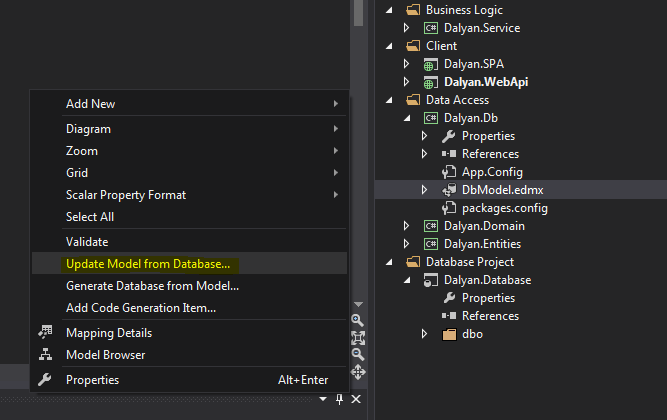 Add
Add
Select Product table and click finish

Now product table is added to edmx file.
3. Add "product" table to defination xml file
Code generation runs with edmx file but you have to add table name to "defination.xml" file. Open Dalyan.Entities -> Defination -> Tables.xml file

Add Product node to xml
="1.0" ="utf-8"
<Tables>
<Table Name="Product"></Table>
</Tables>
4. Generate DbModel with T4 template
Models are generated by this T4 template. Open Dalyan.Entities -> Models -> DbModel.tt file and set you file location to absolutePath
public bool ControlTable(string tableName)
{
XmlDocument doc = new XmlDocument();
string absolutePath = Path.GetFullPath(@"D:\Temp\Dalyan-master\Dalyan-master\Dalyan.Entities\Defination\Tables.xml");
doc.Load(absolutePath);
XmlNodeList xnList = doc.SelectNodes("/Tables/Table[@Name='" + tableName +"']");
foreach (XmlNode xn in xnList)
{
return true;
}
return false;
}
Run Custom Tool to generate models


Your model is ready
namespace Dalyan.Entities.Models
{
using System;
using System.Collections.Generic;
public partial class Product
{
public int Id { get; set; }
public Nullable<int> CompanyId { get; set; }
public string Name { get; set; }
public string Description { get; set; }
public Nullable<double> Price { get; set; }
public Nullable<system.datetime> CreatedDate { get; set; }
public string CreatedIpAddress { get; set; }
public Nullable<int> CreatedUserId { get; set; }
public Nullable<system.datetime> UpdatedDate { get; set; }
public string UpdatedIpAddress { get; set; }
public Nullable<int> UpdatedUserId { get; set; }
public Nullable<bool> IsDeleted { get; set; }
public virtual Company Company { get; set; }
}
}
5. Generate ServiceQuery with T4 template
ServiceQuery is base layer to access database. It has CRUD operations and mapping operations in this layer. Open Dalyan.Domain -> Query -> ServiceQuery.tt file Right click and "Run Custom Tools"
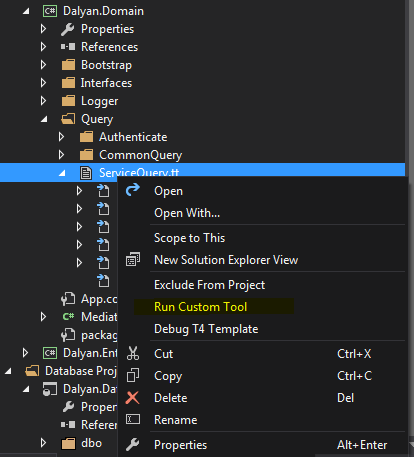

ProductAddQuery
namespace Dalyan.Domain.Query
{
using System;
using Dalyan.Domain;
using System.Linq;
using System.Text;
using Dalyan.Domain.Query;
using System.Data;
using System.Xml;
using Dalyan.Db;
using Entities.Models;
using Dalyan.Entities.Enumerations;
using AutoMapper;
using System.Threading.Tasks;
using System.Collections.Generic;
public class ProductAddQuery : IQuery<dalyan.entities.models.product>
{
public Dalyan.Entities.Models.Product Product{ get; set; }
}
public class ProductAddQueryHandler : IQueryHandler<productaddquery,dalyan.entities.models.product>
{
private readonly DbEntities _db;
public ProductAddQueryHandler()
{
_db = new DbEntities();
}
public Dalyan.Entities.Models.Product Handler(ProductAddQuery query)
{
try
{
var obj = new Dalyan.Db.Product();
obj.Id = query.Product.Id;
obj.CompanyId = query.Product.CompanyId;
obj.Name = query.Product.Name;
obj.Description = query.Product.Description;
obj.Price = query.Product.Price;
obj.CreatedDate = query.Product.CreatedDate;
obj.CreatedIpAddress = query.Product.CreatedIpAddress;
obj.CreatedUserId = query.Product.CreatedUserId;
obj.UpdatedDate = query.Product.UpdatedDate;
obj.UpdatedIpAddress = query.Product.UpdatedIpAddress;
obj.UpdatedUserId = query.Product.UpdatedUserId;
obj.IsDeleted = query.Product.IsDeleted;
_db.Product.Add(obj);
_db.SaveChanges();
query.Product.Id = obj.Id;
return query.Product;
}
catch (Exception ex)
{
throw new ExceptionLog(LogType.DATABASE_INSERT, LogLevel.ERROR, ex, "AddQueryHandler");
}
}
}
}
ProductDeleteQuery
namespace Dalyan.Domain.Query
{
using System;
using Dalyan.Domain;
using System.Linq;
using System.Text;
using Dalyan.Domain.Query;
using System.Data;
using System.Xml;
using Dalyan.Db;
using Entities.Models;
using Dalyan.Entities.Enumerations;
using AutoMapper;
using System.Threading.Tasks;
using System.Collections.Generic;
public class ProductDeleteQuery : IQuery<bool>
{
public int Id { get; set; }
}
public class ProductDeleteQueryHandler : IQueryHandler<dalyan.domain.query.productdeletequery, bool="">
{
private readonly DbEntities _db;
public ProductDeleteQueryHandler()
{
_db = new DbEntities();
}
public bool Handler(Dalyan.Domain.Query.ProductDeleteQuery query)
{
try
{
var obj = new Dalyan.Db.Product();
obj = _db.Product.FirstOrDefault(x => x.Id == query.Id);
obj.IsDeleted = true;
_db.SaveChanges();
return true;
}
catch (Exception ex)
{
throw new ExceptionLog(LogType.DATABASE_DELETE, LogLevel.ERROR, ex, "DeleteQueryHandler");
}
}
}
}
ProductEditQuery
namespace Dalyan.Domain.Query
{
using System;
using Dalyan.Domain;
using System.Linq;
using System.Text;
using Dalyan.Domain.Query;
using System.Data;
using System.Xml;
using Dalyan.Db;
using Entities.Models;
using Dalyan.Entities.Enumerations;
using AutoMapper;
using System.Threading.Tasks;
using System.Collections.Generic;
public class ProductEditQuery : IQuery<dalyan.entities.models.product>
{
public Dalyan.Entities.Models.Product Product{ get; set; }
}
public class ProductEditQueryHandler : IQueryHandler<producteditquery, dalyan.entities.models.product="">
{
private readonly DbEntities _db;
public ProductEditQueryHandler()
{
_db = new DbEntities();
}
public Dalyan.Entities.Models.Product Handler(ProductEditQuery query)
{
try
{
var obj = new Dalyan.Db.Product();
obj = _db.Product.FirstOrDefault(x => x.Id == query.Product.Id);
obj.Id = query.Product.Id;
obj.CompanyId = query.Product.CompanyId;
obj.Name = query.Product.Name;
obj.Description = query.Product.Description;
obj.Price = query.Product.Price;
obj.CreatedDate = query.Product.CreatedDate;
obj.CreatedIpAddress = query.Product.CreatedIpAddress;
obj.CreatedUserId = query.Product.CreatedUserId;
obj.UpdatedDate = query.Product.UpdatedDate;
obj.UpdatedIpAddress = query.Product.UpdatedIpAddress;
obj.UpdatedUserId = query.Product.UpdatedUserId;
obj.IsDeleted = query.Product.IsDeleted;
_db.SaveChanges();
return query.Product;
}
catch (Exception ex)
{
throw new ExceptionLog(LogType.DATABASE_UPDATE, LogLevel.ERROR, ex, "EditQueryHandler");
}
}
}
}
ProductGetAllQuery
namespace Dalyan.Domain.Query
{
using System;
using Dalyan.Domain;
using System.Linq;
using System.Text;
using Dalyan.Domain.Query;
using System.Data;
using System.Xml;
using Dalyan.Db;
using Entities.Models;
using Dalyan.Entities.Enumerations;
using AutoMapper;
using System.Threading.Tasks;
using System.Collections.Generic;
public class ProductGetAllQuery : IQuery<ilist<dalyan.entities.models.product>>
{
}
public class ProductGetAllQueryHandler : IQueryHandler<productgetallquery, dalyan.entities.models.product="">>
{
private readonly DbEntities _db;
public ProductGetAllQueryHandler()
{
_db = new DbEntities();
}
public IList<dalyan.entities.models.product> Handler(ProductGetAllQuery query)
{
try
{
var result = _db.Product.Include("Company").Where(x => x.IsDeleted == false).AsEnumerable().ToList();
Mapper.CreateMap<dalyan.db.company, dalyan.entities.models.company="">();
Mapper.CreateMap<dalyan.db.product, dalyan.entities.models.product="">().ForMember(c => c.Company, d => d.MapFrom(s => s.Company));
return Mapper.Map<ienumerable<dalyan.db.product>, IEnumerable<dalyan.entities.models.product>>(result).ToList();
}
catch (Exception ex)
{
throw new ExceptionLog(LogType.DATABASE_SELECT, LogLevel.ERROR, ex, "GetAllQueryHandler");
}
}
}
}
ProductRetrieveQuery
---------------------------------------------------------------
namespace Dalyan.Domain.Query
{
using System;
using Dalyan.Domain;
using System.Linq;
using System.Text;
using Dalyan.Domain.Query;
using System.Data;
using System.Xml;
using Dalyan.Db;
using Entities.Models;
using Dalyan.Entities.Enumerations;
using AutoMapper;
using System.Threading.Tasks;
using System.Collections.Generic;
public class ProductRetrieveQuery : IQuery<dalyan.entities.models.product>
{
public int Id { get; set; }
}
public class ProductRetrieveQueryHandler : IQueryHandler<productretrievequery, dalyan.entities.models.product="">
{
private readonly DbEntities _db;
public ProductRetrieveQueryHandler()
{
_db = new DbEntities();
}
public Dalyan.Entities.Models.Product Handler(ProductRetrieveQuery query)
{
try
{
var result = _db.Product.Include("Company").Where(x => x.IsDeleted == false && x.Id == query.Id).FirstOrDefault();
Mapper.CreateMap<dalyan.db.company, dalyan.entities.models.company="">();
Mapper.CreateMap<dalyan.db.product, dalyan.entities.models.product="">().ForMember(c => c.Company, d => d.MapFrom(s => s.Company));
return Mapper.Map<dalyan.db.product, dalyan.entities.models.product="">(result);
}
catch (Exception ex)
{
throw new ExceptionLog(LogType.DATABASE_SELECT, LogLevel.ERROR, ex, "RetrieveQueryHandler");
}
}
}
}
6. Generate Service with T4 template
Service Layer is your business side. It calls the Domain layer to access database.
Open Dalyan.Service -> Services -> ServiceQueryHandler.tt file and "run custom tools"
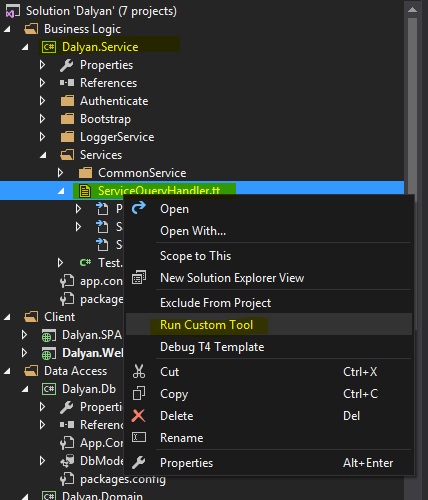
Your service code is ready.
namespace Dalyan.Service.Services
{
using System;
using SimpleInjector;
using Dalyan.Domain;
using Entities.Contracts;
using System.Linq;
using System.Text;
using Dalyan.Entities.Interfaces;
using Dalyan.Domain.Query;
using System.Data;
using System.Xml;
using Dalyan.Entities.Models;
using Dalyan.Entities.Enumerations;
using System.Threading.Tasks;
using System.Collections.Generic;
public class ProductService
{
private readonly Container _container;
public ProductService(Container container)
{
_container = container;
}
public ServiceResult<product> Add(Product obj)
{
try
{
IMediator service = _container.GetInstance<imediator>();
IUserContext currentUser = _container.GetInstance<iusercontext>();
obj.CreatedDate = DateTime.Now;
obj.CreatedUserId = currentUser.CurrentUserIdentity.UserID;
obj.CreatedIpAddress = currentUser.CurrentUserIdentity.IpAddress;
obj.UpdatedDate = DateTime.Now;
obj.UpdatedUserId = currentUser.CurrentUserIdentity.UserID;
obj.UpdatedIpAddress = currentUser.CurrentUserIdentity.IpAddress;
obj.IsDeleted = false;
var query = new ProductAddQuery();
query.Product = obj;
return new ServiceResult<product>(service.Proccess(query), message: ClientErrorMessage.Success(), state: ServiceResultStates.SUCCESS);
}
catch(ExceptionLog ex)
{
LoggerService.Logger.Log(_container, ex);
return new ServiceResult<product>(result: null, message: ClientErrorMessage.Error(), state: ServiceResultStates.ERROR);
}
}
public ServiceResult<product> Edit(Product obj)
{
try
{
IMediator service = _container.GetInstance<imediator>();
IUserContext currentUser = _container.GetInstance<iusercontext>();
var query = new ProductEditQuery();
obj.UpdatedDate = DateTime.Now;
obj.UpdatedUserId = currentUser.CurrentUserIdentity.UserID;
obj.UpdatedIpAddress = currentUser.CurrentUserIdentity.IpAddress;
query.Product = obj;
return new ServiceResult<product>(service.Proccess(query), message: ClientErrorMessage.Success(), state: ServiceResultStates.SUCCESS);
}
catch(ExceptionLog ex)
{
LoggerService.Logger.Log(_container, ex);
return new ServiceResult<product>(result: null, message: ClientErrorMessage.Error(), state: ServiceResultStates.ERROR);
}
}
public ServiceResult<product> Retrieve(int Id)
{
try
{
IMediator service = _container.GetInstance<imediator>();
var query = new ProductRetrieveQuery{ Id = Id };
return new ServiceResult<product>(service.Proccess(query), message: ClientErrorMessage.Success(), state: ServiceResultStates.SUCCESS);
}
catch(ExceptionLog ex)
{
LoggerService.Logger.Log(_container, ex);
return new ServiceResult<product>(result: null, message: ClientErrorMessage.Error(), state: ServiceResultStates.ERROR);
}
}
public ServiceResult<ilist<product>> GetAll()
{
try
{
IMediator service = _container.GetInstance<imediator>();
var query = new ProductGetAllQuery();
return new ServiceResult<ilist<product>>(service.Proccess(query), message: ClientErrorMessage.Success(), state: ServiceResultStates.SUCCESS);
}
catch(ExceptionLog ex)
{
LoggerService.Logger.Log(_container, ex);
return new ServiceResult<ilist<product>>(result: null, message: ClientErrorMessage.Error(), state: ServiceResultStates.ERROR);
}
}
public ServiceResult<string> Delete(int Id)
{
try
{
IMediator service = _container.GetInstance<imediator>();
var query = new ProductDeleteQuery{ Id = Id };
return new ServiceResult<string>(service.Proccess(query).ToString(), message: ClientErrorMessage.Success(), state: ServiceResultStates.SUCCESS);
}
catch(ExceptionLog ex)
{
LoggerService.Logger.Log(_container, ex);
return new ServiceResult<string>(result: null, message: ClientErrorMessage.Error(), state: ServiceResultStates.ERROR);
}
}
}
}
7. Generate WebAPI controller with T4 template
The last one is WebAPI controller layer. Your SPA access this layer to CRUD operations. For authentication add [UserAuthorize] Attributes to your action. [UserAuthorize] authentication is default.
Open Dalyan.WebApi project -> Controllers -> ControllerService.tt file

Your Controller is ready
namespace Dalyan.WebApi.Controllers
{
using System;
using SimpleInjector;
using Dalyan.Entities;
using System.Linq;
using System.Net;
using System.Web.Http;
using System.Net.Http;
using Dalyan.Entities.Models;
using Dalyan.Service;
using Entities.Contracts;
using Dalyan.WebApi.Attributes;
using Dalyan.Service.Services;
using System.Collections.Generic;
public class ProductController : ApiController
{
private readonly Container _container;
public ProductController(Container container)
: base()
{
_container = container;
}
[UserAuthorize]
[HttpPost]
public ServiceResult<product> Add(Product obj)
{
ProductService service = new ProductService(_container);
return service.Add(obj);
}
[UserAuthorize]
[HttpPost]
public ServiceResult<product> Edit(Product obj)
{
ProductService service = new ProductService(_container);
return service.Edit(obj);
}
[UserAuthorize]
[HttpPost]
public ServiceResult<product> Retrieve(int Id)
{
ProductService service = new ProductService(_container);
return service.Retrieve(Id);
}
[UserAuthorize]
[HttpPost]
public ServiceResult<ilist<product>> GetAll()
{
ProductService service = new ProductService(_container);
return service.GetAll();
}
[UserAuthorize]
[HttpPost]
public ServiceResult<string> Delete(int Id)
{
ProductService service = new ProductService(_container);
return service.Delete(Id);
}
}
}
8. Check WebAPI actions
For testing add some records to database
GO
SET IDENTITY_INSERT [dbo].[Company] ON
GO
INSERT [dbo].[Company] ([Id], [Name], [IsDeleted]) VALUES (1, N'Apple', 0)
GO
INSERT [dbo].[Company] ([Id], [Name], [IsDeleted]) VALUES (2, N'Samsung', 0)
GO
SET IDENTITY_INSERT [dbo].[Company] OFF
GO
SET IDENTITY_INSERT [dbo].[Product] ON
GO
INSERT [dbo].[Product] ([Id], [CompanyId], [Name], [Description], [Price], [CreatedDate], [CreatedIpAddress], [CreatedUserId], [UpdatedDate], [UpdatedIpAddress], [UpdatedUserId], [IsDeleted]) VALUES (1, 1, N'IPhone 6s', N'The only thing that’s changed is everything.', 350, CAST(N'2016-01-22 00:00:00.000' AS DateTime), N'192.1681.1', 1, CAST(N'2016-01-22 00:00:00.000' AS DateTime), N'192.1681.1', 1, 0)
GO
INSERT [dbo].[Product] ([Id], [CompanyId], [Name], [Description], [Price], [CreatedDate], [CreatedIpAddress], [CreatedUserId], [UpdatedDate], [UpdatedIpAddress], [UpdatedUserId], [IsDeleted]) VALUES (2, 2, N'Samsung Galaxy S6 edge', N'Big screen. Big entertainment.', 300, CAST(N'2016-01-22 00:00:00.000' AS DateTime), N'192.1681.1', 1, CAST(N'2016-01-22 00:00:00.000' AS DateTime), N'192.1681.1', 1, 0)
GO
SET IDENTITY_INSERT [dbo].[Product] OFF
GO
You can test you api from SPA code or postman chrome extension https://chrome.google.com/webstore/detail/postman/fhbjgbiflinjbdggehcddcbncdddomop
The result of out call
http://localhost/Dalyan.WebApi/Product/GetAll
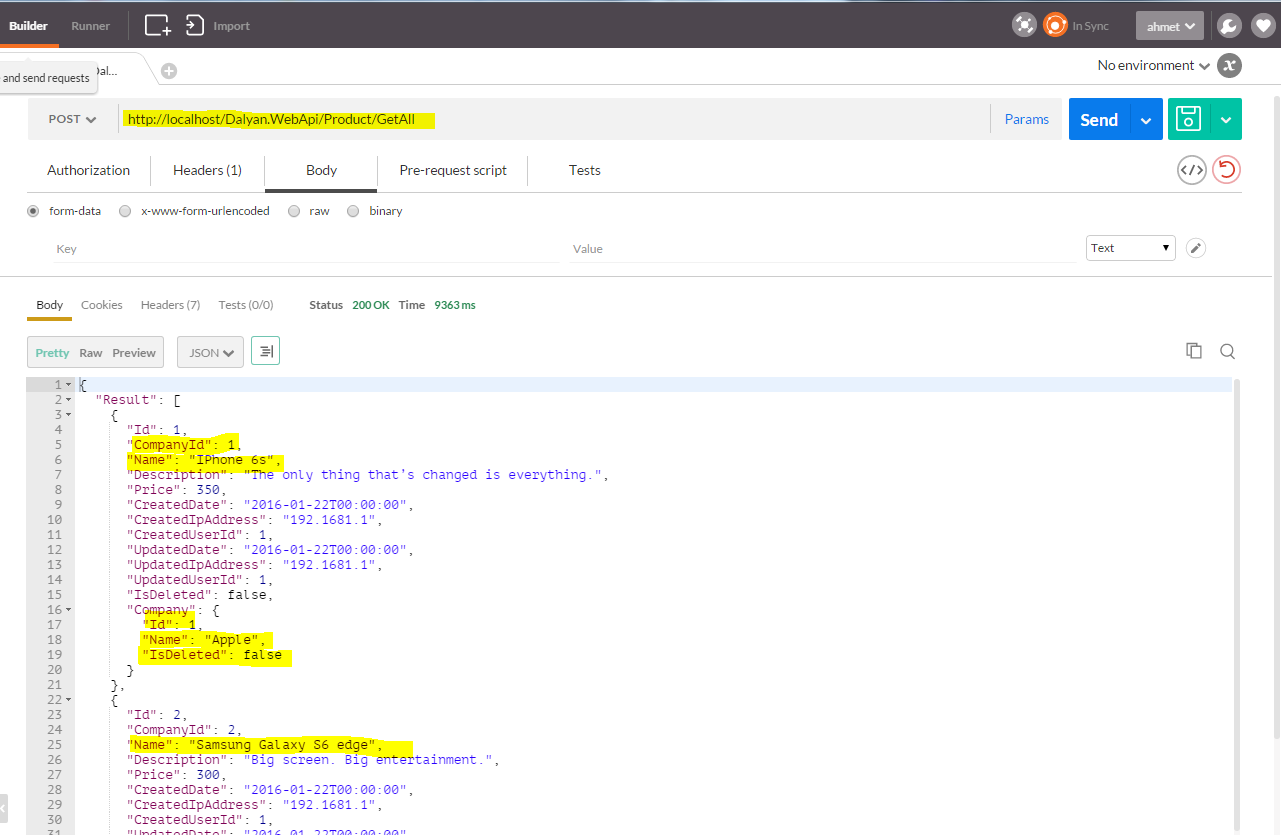
{
"Result": [
{
"Id": 1,
"CompanyId": 1,
"Name": "IPhone 6s",
"Description": "The only thing that’s changed is everything.",
"Price": 350,
"CreatedDate": "2016-01-22T00:00:00",
"CreatedIpAddress": "192.1681.1",
"CreatedUserId": 1,
"UpdatedDate": "2016-01-22T00:00:00",
"UpdatedIpAddress": "192.1681.1",
"UpdatedUserId": 1,
"IsDeleted": false,
"Company": {
"Id": 1,
"Name": "Apple",
"IsDeleted": false
}
},
{
"Id": 2,
"CompanyId": 2,
"Name": "Samsung Galaxy S6 edge",
"Description": "Big screen. Big entertainment.",
"Price": 300,
"CreatedDate": "2016-01-22T00:00:00",
"CreatedIpAddress": "192.1681.1",
"CreatedUserId": 1,
"UpdatedDate": "2016-01-22T00:00:00",
"UpdatedIpAddress": "192.1681.1",
"UpdatedUserId": 1,
"IsDeleted": false,
"Company": {
"Id": 2,
"Name": "Samsung",
"IsDeleted": false
}
}
],
"ResultList": null,
"State": 0,
"Message": "Your transaction has been completed successfully.",
"PortalTask": null
}
Generate Custom Database Operations
You can add CRUD operations with T4 template automaticly. Also you can add custom database operations to your project.
I will axplain the step by step how to add a new database operations.
The example is password change operation.
- Create ChangePassword Query and Query Handler
- Create ChangePassword Service
- Create ChangePassword WebAPI method
Create ChangePassword Query and Query Handler
Open Dalyan.Domain -> Query -> CustomQuery All db operations are in Dalyan.Domain project. Create a query class.
namespace Dalyan.Domain.Query
{
using System;
using Dalyan.Domain;
using System.Linq;
using System.Text;
using Dalyan.Domain.Query;
using System.Data;
using System.Xml;
using Dalyan.Db;
using Entities.Models;
using Dalyan.Entities.Enumerations;
using AutoMapper;
using System.Threading.Tasks;
using System.Collections.Generic;
public class ChangePasswordQuery : IQuery<bool>
{
public int Id { get; set; }
public string Password { get; set; }
}
public class ChangePasswordQueryHandler : IQueryHandler<changepasswordquery, bool="">
{
private readonly DbEntities _db;
public ChangePasswordQueryHandler()
{
_db = new DbEntities();
}
public bool Handler(ChangePasswordQuery query)
{
try
{
var obj = new Dalyan.Db.User();
obj = _db.User.FirstOrDefault(x => x.Id == query.Id);
obj.Password = query.Password;
obj.UpdatedDate = DateTime.Now;
_db.SaveChanges();
return true;
}
catch (Exception ex)
{
throw new ExceptionLog(LogType.DATABASE_UPDATE, LogLevel.ERROR, ex, "ChangePasswordQuery");
}
}
}
}
ChangePasswordQuery class have your parameters and used in handler method. The parameter values pass with query class to handler.
Create ChangePassword Service
WebAPI use service layer to access database so you have to add a service class to Dalyan.Service solution.
namespace Dalyan.Service.Services
{
using System;
using SimpleInjector;
using Dalyan.Domain;
using System.Linq;
using System.Text;
using Dalyan.Domain.Query;
using System.Data;
using System.Xml;
using Dalyan.Entities.Models;
using Dalyan.Entities.Enumerations;
using System.Threading.Tasks;
using System.Collections.Generic;
using Entities.Interfaces;
using Entities.Contracts;
public class ChangePasswordService
{
private readonly Container _container;
public ChangePasswordService(Container container)
{
_container = container;
}
public ServiceResult<string> ChangePassword(int Id, string Password)
{
try
{
IMediator service = _container.GetInstance<imediator>();
var query = new ChangePasswordQuery { Id = Id, Password=Password };
return new ServiceResult<string>(service.Proccess(query).ToString(), message: ClientErrorMessage.Success(), state: ServiceResultStates.SUCCESS);
}
catch (ExceptionLog ex)
{
LoggerService.Logger.Log(_container, ex);
return new ServiceResult<string>(result: "false", message: ClientErrorMessage.Error(), state: ServiceResultStates.ERROR);
}
}
}
}
We use mediator pattern and our handlers execute automaticly with mediator class with IoC.
Create ChangePassword WebAPI method
The last step is create WebAPI method. SPA project uses WebAPI methods to access database. You can add the method any controller.
[ClientAuthorize]
[HttpPost]
public ServiceResult<string> ChangePassword(string password)
{
ChangePasswordService service = new ChangePasswordService(_container);
IUserContext currentUser = _container.GetInstance<iusercontext>();
return service.ChangePassword(currentUser.CurrentUserIdentity.UserID, password);
}
Points of Interest
You can develop your project on Dalyan Web Application Template.
